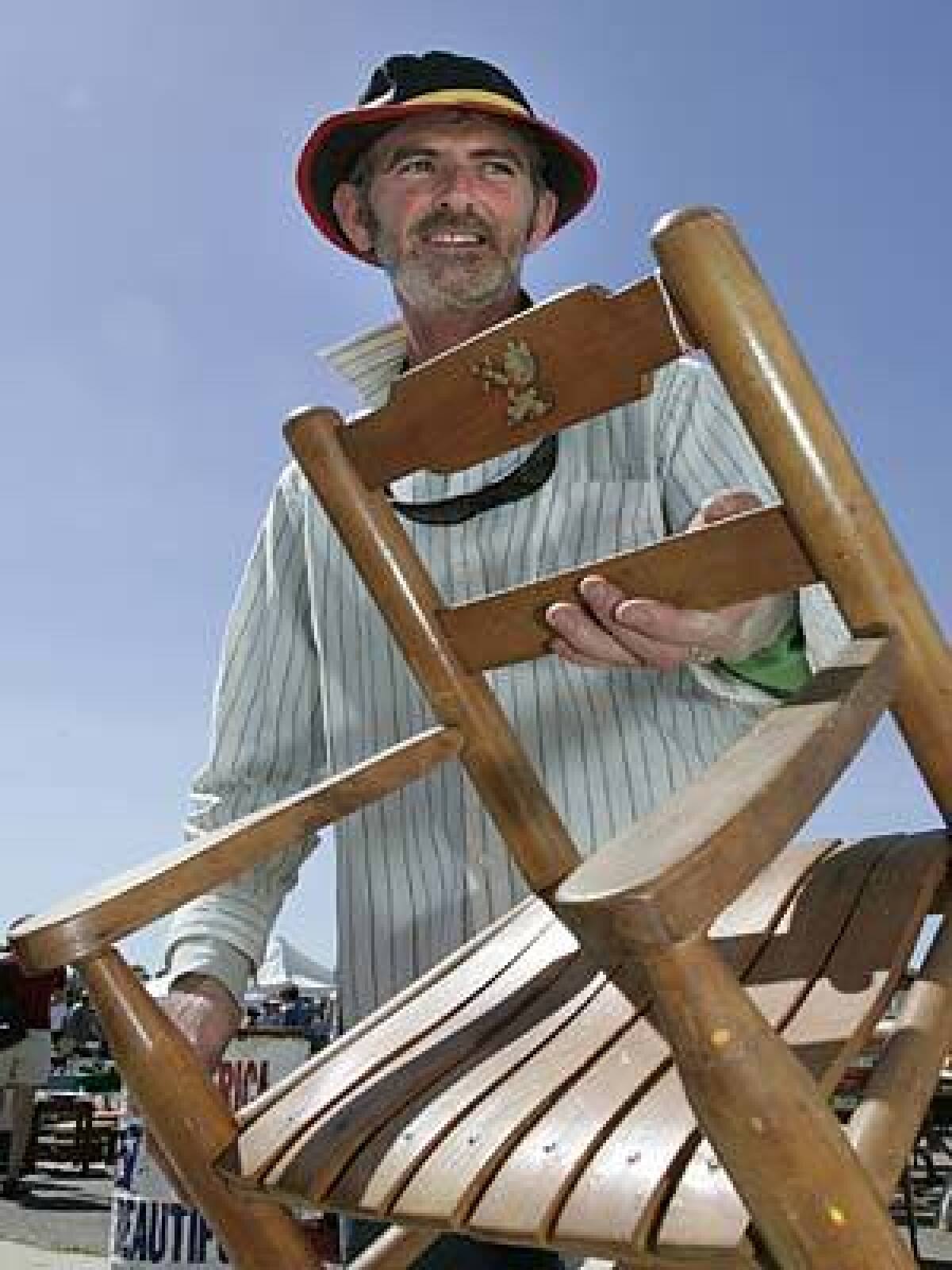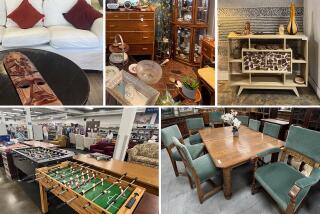A master of what could be

NIALL BOURKE has an odd way of taking a seat. He faces it and places his right knee in the middle of the chair, then puts one hand on the arm and the other on the back. Gently, he rocks his body to and fro. If the chair wobbles, it will need to be re-glued and clamped. If not, he’ll look more closely to determine when and where it was built, what wood was used and how the piece was crafted.
Bourke knows his stuff. He studied carpentry in school in his native Limerick, Ireland, and then in the mid-’80s moved to Greenwich, England, where he learned to restore wood paneling in the homes of aristocrats. Today, in a Culver City workshop, he restores antiques, builds custom designs with aged lumber and specializes in applying a high-gloss French polish technique to furniture for dealers, decorators and customers with family heirlooms.
“I’m the one that teaches a piece of furniture manners, if you like,” he says. “We knock some sense into it, dress it up and make it look presentable.”
For Bourke, spotting faded glory is part of the challenge. On a hot Sunday, he leads the way through the Ventura Flea Market at the county fairgrounds. The goal: to identify wood furniture worth the time and money needed to restore it.
Almost immediately, he spots a pine armoire in a booth run by Charlotte Ophaug, who started the antique mall in the old Santa Barbara County train depot of Los Alamos. Bourke’s first guess is that it comes from the former Czechoslovakia, Bulgaria or Romania.
“It’s definitely an Eastern Bloc country piece,” he says. “You can tell that by the two panels on the door, the turned column in the front and the finials.” The piece has turned feet, which rules out a British heritage, because the British tend to use bracket feet on pieces of this size.
Opening the doors, Bourke spies the original hooks used to hang coats. “It’d never be used for that again,” he says. He scrapes his fingernail across the surface and determines that is has been varnished rather than waxed. This means it can be lightly sanded and re-colored, unlike waxed furniture, which requires significantly more work to refinish.
At $450, the price is good.
“I’d put in three shelves and maybe add a drawer for books,” Bourke says. “If it was ebonized, it would be something else. What would really make this sell to a designer would be to make it black.”
The modifications and finishing work would run at least $500, but Bourke believes that he could sell it easily for $2,000 to a designer, who in turn would raise the price for a client.
At Stan Lester’s booth, Bourke comes upon something called a Hoosier cabinet, kitchen fixtures that often came equipped with a built-in flour sifter. Nearby are century-old American Arts and Crafts pieces.
“These are quarter-sawn oak, which is wood cut on an angle to reveal more of the wood grain,” Bourke says. “If you stand back, it looks like lightning bolts flashing across the wood. Quarter-sawn wood is the prime cut.”
“It’s the filet, the filet mign-oak,” Lester adds. “They don’t do it anymore because it wastes so much wood that it isn’t profitable.”
The pieces are a little shiny for Bourke’s taste. He says they are varnished, rather than shellacked. Varnish, he explains, is made from a tree resin, whereas shellac is produced by an insect that feeds on tree gum and excretes the shiny substance. The former was developed about 150 years ago; the latter goes back centuries. There’s one way to tell them apart.
“If these pieces were shellacked,” Bourke says, “the finish would crack and bubble in this kind of heat.”
In another booth, a child’s rocker with a decal on the back rail is $35. It’s a steal, Bourke says, and only lacks for a good waxing. “This has personality. It’s machine-made but hand-assembled,” he says, pointing out the uniformity of its legs and individually nailed wooden slats.
He holds it aloft, examining the seat at eye level. “The wood has been steam bent on the seat so your butt will sit nicely into it.”
AT Old Pine Furnishings, an Asian importer based in Glendale, Bourke hits the mother lode.
“Dovetails,” he says joyfully, looking at a drawer with flared pegs and grooves that fit together like gear teeth -- a technique that was all but abandoned for mass manufacturing.
“This is what it’s all about,” he says, adding that he can tell the age and origin of almost any piece of furniture by its dovetail joinery. “These are hand-cut, which are the most sought after.”
Nearby, underneath a portable sunshade, two young women sit with an antique sofa frame, the only item in their booth. Bourke examines the carving, which is irregular and thus probably done by hand.
“It’s neoclassical, close-grained pine with fluted tapering legs. French,” Bourke decides. It is also much longer and deeper than a settee, elegantly proportioned and detailed. “You’d have to tighten it up, glue it and clamp it and polish it. You’re looking at about $600 for that, and then you’d want to reupholster it properly with springs and down cushions.” He estimates that expense at about $1,000, excluding the fabric.
“We thought we might upholster it,” one seller says. “We’re actually just trying to find a nice home for it.”
After paying $150 for the frame, Bourke assures them that they have.
INFOBOX
Fix tear and show off wear
“IF you can’t disguise it, emphasize it,” says wood restorer Niall Bourke, whose Culver City workshop is called Kipper (www.kipper.biz). “Dings, patina and variation of color give antiques their personality.” Here, his tips on finding and fixing flea market furniture:
Surfaces: Run your fingernail across an inconspicuous spot. Furniture that has been varnished will flake; pieces that have been waxed will “putty up under your fingernail,” Bourke says. “It’s a huge expense if you want to refinish a waxed piece. You have to use steel wool and turpentine, and let it sit in the sun and melt the wax. It’s a lot of labor and time.” Varnished or shellacked pieces are easier.
Drawers: Most 20th century furniture is labeled with a burned-in brand or metal tag in the drawers. On pieces that look older, look closely at how the front of the drawer is joined to the side panels. “Dovetail joinery is a sign of age and quality,” Bourke says. “I would never buy an old piece without it.”
Screws: Fasteners can offer clues to the age of a piece. If screws are rusted into place, chances are they are original to the furniture. Phillips-head screws didn’t become popular until the 1930s.
Hardware: Aged handles and knobs have character. “If you don’t like patina, don’t try to clean up brass, iron, copper and bronze,” he says. “Nothing looks worse than beautifully restored old wood with shiny metal pulls and handles.”
Leather: If you find dining room chairs that need to have the wood refinished and the upholstered seats replaced, the difference between cotton duck and long-lasting leather is minimal, and leather will raise the resale value. Bourke shops at Caldelle Leather in Santa Monica (www.caldelle.com).
Woven seats : Avoid chairs with woven panels in poor condition. The cost of reweaving a seat in rush or cane can come to $125; the chair back will cost just as much. When repairs are necessary, Bourke recommends Cane & Basket Supply in L.A. (www.caneandbasket.com).
Staples: Use them in the office, not on upholstery. “If you see upholstery tacks, or evidence that they have been there, it makes a piece more authentic,” Bourke says. “If you want to honor an old piece, you can reupholster with nailhead trim, which is very hip these days.”
Dings: Accidentally banging a vacuum cleaner on furniture legs can leave white marks. Bourke removes them with pigmented paste wax in a shade darker than the wood. He uses French-made Pate Dugay, applied with superfine steel wool.


